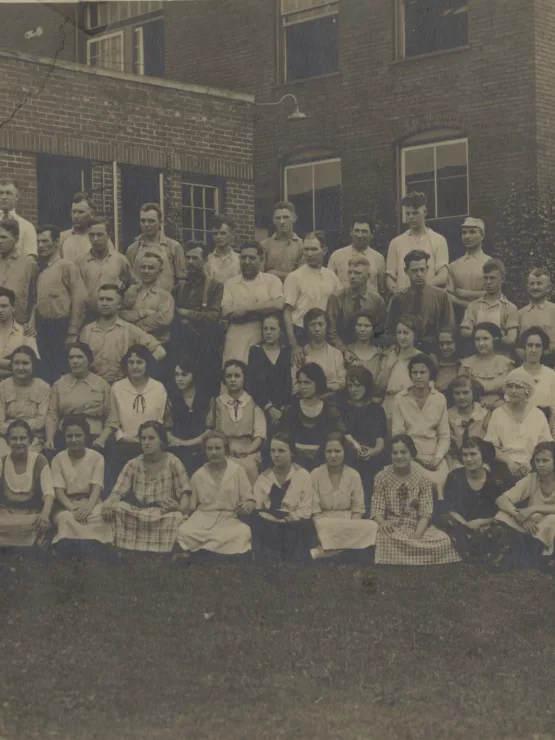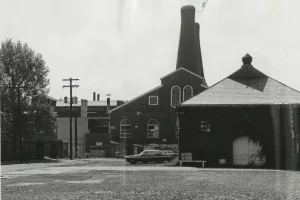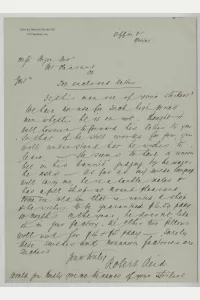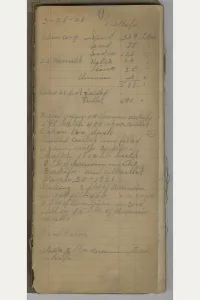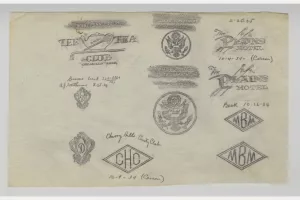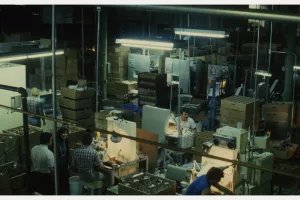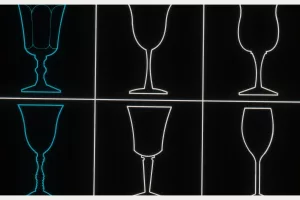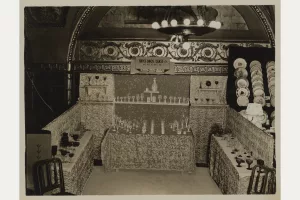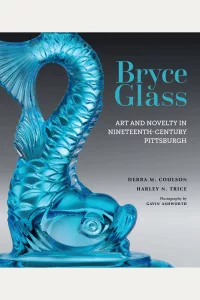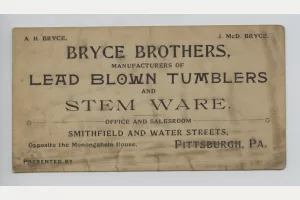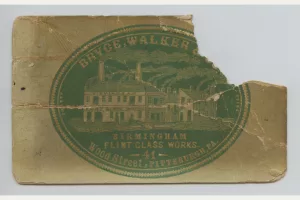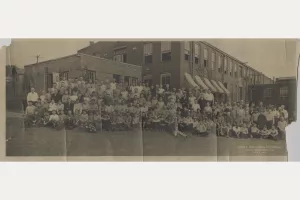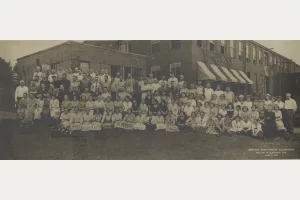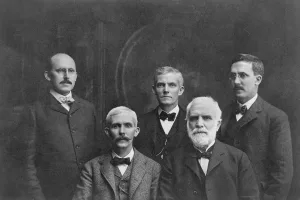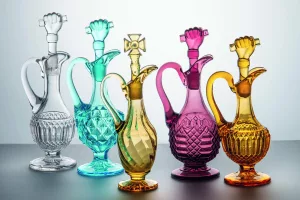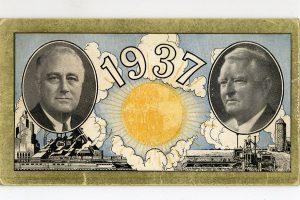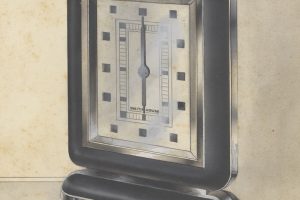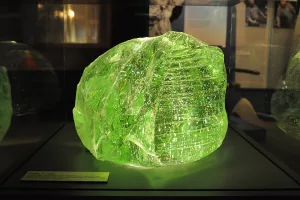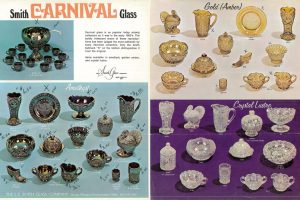The History Center has been home to Pittsburgh’s legacy in glass for 25 years. The city’s roots as a center for glass manufacturing can be traced to the late 18th century. Of the regions many early glasshouses, the Bryce glass company played a significant role in glassware manufacturing. The Bryce family’s patriarch, James Bryce, Sr. and his son James S. Bryce, Jr. first worked for Bakewell, Page & Bakewell, a Pittsburgh glass firm and one of the country’s first flint glass manufacturers. In 1850 James S. Bryce formed his own company with his brothers as well as Frederick and James McKee.
In 2006, the corporate archive of the Bryce Brothers Company was donated to the History Center, making it one of the largest collections on Pittsburgh glass manufacturing in the organization’s holdings. Dating from 1828, the collection’s oldest records provide insights into the early history of the Bryce company before its relocation to Mt. Pleasant, Pa. More contemporary materials reflect the acquisition of the Bryce Company by Lenox, Inc., in 1965 and document the company’s evolution through the Mount Pleasant plant closing in 2002. Given the breadth, volume, and uniqueness of its records, this corporate archive is a veritable treasure trove of materials relating to the industrial and design history of glass manufacturing in Mount Pleasant, Pa. The records in the Bryce Brothers Company collection, filling 95 boxes, provide insights into the production and sale of its glassware over time.
Here are just some of the highlights from this prodigious archival collection.
Labor Relations
Complementing the collection’s early business and administrative records is an intriguing cache of records relating to 19th century labor relations. Researchers can discover documentation of labor compensation concerns that arose over time between Bryce Brothers Company and other stakeholders, including the American Flint Glass Workers Union, the United States Glass Company, the Glass Table Ware Manufacturers, and individual employees. One notable document is an original notice handwritten by James S. Bryce directed to glassworkers in November 1878. This direct communication by what was then Bryce Walker & Co. was meant to assert the company’s authority to set employee compensation structures as well as to dictate which products it manufactured. Based on supporting documentation in the collection, this formal communication is a direct reiteration of an agreement forged between Bryce Walker & Co. and nine other local glass houses that were members of the Glass Table Ware Manufacturers of Pittsburgh. The labor dispute that resulted from this notice halted production in local glass houses that did not resume again until February 1879. Bryce Walker & Co. was among the few glass houses that restarted operations with experienced glassworkers, some of whom personally received “threatening letters ornamented with skulls, crossbones, and coffins” for their decision to return to work.
Glass Manufacturing
In addition to labor records, this collection also includes original design and production materials for the company’s glassware. Notably, the company’s glass manufacturing process is documented in two batch books dating to c. 1877. The second batch book belonged to William McNaughton and details the trials and tribulations of mixing colored glass. Dating to 1921, the first page of the volume reveals the challenge McNaughton faced to determine the appropriate amount of uranium to add to a batch to attain a particular shade of canary (McNaughton’s answer: three pounds). Complementing these batch books is a volume titled “Engraving and decorating for etched starts” that contains original notes and formulae for polishing acid, white acid, Erie acid, frosting acid, and transfer wax used to etch designs into pieces of glassware. Alongside the Bryce Brothers batch books are pantograph etch and band books, whose pages are filled with band design sketches and production specifications. Particularly informative are the pantograph etch books, which include numerous sketches of the crests and logos of Bryce Brothers clients from the 1920s through ’40s. Clients depicted through their emblems include, but are not limited to: Curtiss-Wright, the U.S. State Department, the Top of the Needle Restaurant, the Hotel San Diego, Wesley Memorial Hospital, and numerous other hotels, restaurants, exclusive social clubs, and country clubs.
Acquisition by Lenox, Inc.
In 1965, Lenox, Inc. strategically acquired the Bryce Brothers Company; the vision being to manufacture glass that would complement their stronghold in the chinaware market. Records dating to this era document the management, design, production, and marketing of the company’s glassware under this new masthead. Of interest within these records is an Introducing Lenox Crystal booklet created for china salesmen to familiarize them with the company’s expansion into the glassware industry. Also related to the acquisition and early management of Bryce Brothers is the outgoing and select incoming correspondence of John M. Tassie, president of Lenox, Inc. These letters, which include in-depth business and financial assessments of Bryce Brothers, provide a substantive glimpse into the Bryce Brothers Company in the months preceding the acquisition in 1965. In addition, this collection contains press releases and other corporate publications that notably interweave the long history of Bryce Brothers with the Lenox brand in order to announce the arrival of the china manufacturer into the crystal glassware market.
What fills the remaining 70 boxes and comprises the vast majority of the corporate archives are product design records dating from the 1970s through the 1990s. These primarily consist of new product introductions, design drawings, cutting drawings, CAD drawings, production specifications, quality control records, standard operating procedures, and designer files for both chinaware and crystalware. These materials reflect the process of designing, manufacturing, and assessing crystal glassware pieces produced by Lenox, Inc. Particularly revelatory are the files of individual designers that document the creative and administrative efforts expended in the design and development of glassware at Lenox during the latter half of the 20th century.
Augmenting these designer files are Lenox’s New Product Introductions, which span from 1976 to 2000 and internally track each of the new crystal products placed on the market that year. Kept in chronological order, the New Product Introductions list the pattern line and item name as well as the piece’s dimensions and a sketch for each crystal product introduced by the company.
Learn More
Join us for an evening of rich conversation drawn from an exciting new book on the Bryce glass company on April 11. Written by Bryce descendant Harley Trice and life-long Pittsburgher Debra Coulson, “Bryce Glass: Art and Novelty in Nineteenth-Century Pittsburgh” promises to be “a vibrant study of the history and production of the Bryce glass company, one of the most successful designers and producers of pattern glass tableware, novelties and lamps in the nineteenth century.” Event attendees will have an opportunity to view original historic materials selected from the Bryce Brothers collection that will be on display for one day only. A book sale and signing will close the program.
Those wishing to conduct their own research into these materials are welcome to view them in person at the Heinz History Center’s Detre Library & Archives. Access is free and open to all during normal research hours (Wednesday-Saturday from 10:00 a.m. to 5:00 p.m.).
A version of this article was formerly published in Western Pennsylvania History magazine.
